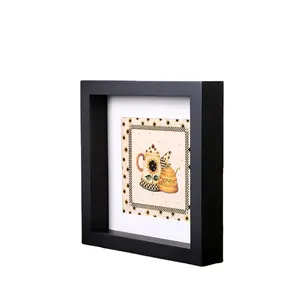Introduction
Art and photographs are more than just visual elements; they are expressions of creativity, memories, and stories that deserve to be preserved and displayed in the best possible way. The choice of glass for picture frames, often overlooked, plays a pivotal role in this preservation and display. This article delves into the world of picture framing glass, exploring its importance, the various types available, and how to choose and maintain the right one for your artwork. From the conventional clear glass to the high-end UV protective glass, each type offers unique features that can enhance your art while protecting it from damaging factors.
Understanding the Importance of Glass in Picture Framing
Picture framing glass, also known as glazing or conservation glass, plays a crucial role in art framing. Its primary purpose is to exhibit the artwork clearly while protecting it from damaging factors such as light, humidity, heat, and soiling. Some types of glass and acrylic can also protect against physical damage from glass breakage and malicious attacks. The glass's visibility, measured by light transmission, is essential as it determines how well the artwork behind it is displayed.
Types of Glass for Picture Frames
Picture framing glass comes in various types, each with unique features. High-end UV protective glass offers unmatched clarity and protection, blocking 99% UV rays, making it ideal for valuable artwork. Conservation glass is commonly used in custom framing, providing UV protection and strength. Anti-reflective glass offers an anti-reflective coating but less UV protection, while clear color transmission glass is known for its clear color transmission. Anti-glare glass and reflection control glass offer anti-glare properties, with the former providing UV protection. Lastly, premium clear glass combines UV protection with anti-reflection.
Clear Glass
The clear finish is the most conventional choice for picture frame glass, ideal for most types of art. It's like looking through a window, offering an unaltered view of your artwork. If your art is colorful, clear glass would be the best option, as it doesn't soften any of the colors in your photo or artwork. However, keep in mind that clear glass is reflective and could cause glare if placed near a window or a bright light source.
Non-Glare Glass
Non-Glare Acrylic, also known as plexi-glass, is a popular choice for picture framing. It offers an acid-free, non-reflective matte surface that minimizes glare and reflection, filtering 90% of harmful UV rays. This lightweight, shatter-resistant material is 1/8” thick and economically priced for professional exhibition. However, it's not recommended for frame designs using spacers or shadowbox treatments. The artwork should be placed within 1/4” of the acrylic using a mat board up to 8ply in thickness.
UV Protection Glass
UV protection is crucial for maintaining optimal eye health, and this applies to picture frame glass as well. UV protective glass for picture frames helps prevent damage and fading caused by harmful UV rays. This type of glass is especially beneficial for preserving artworks, photographs, and other valuable items displayed in frames. It blocks the UV rays from penetrating the glass, thereby protecting the enclosed items from potential UV damage. Choosing UV protective glass for your picture frames is an effective way to ensure the longevity of your displayed items.
High-End UV Protective Glass
High-end UV protective glass is a top-tier choice for custom framing. Its exceptional clarity and uncompromised protection make it stand out in the market. Moreover, it's now even better to handle due to its easy-to-clean, more durable surface. This makes high-end UV protective glass not just a protective element, but also an enhancing feature for your picture frames.
Acrylic Glass
Acrylic, also known as plexiglass, is a popular choice for picture frames due to its high quality and durability. It offers protection to artwork without distortion or the risk of shattering. Acrylic sheets are acid-free, lightweight, and come in five variations to suit different needs. While Standard and Non-Glare Acrylic offer 90% UV resistance, for conservation grade protection, choose acrylic with 97% UV resistance or higher. UV, UV Non-Glare, and high-end UV protective acrylic all offer 99% UV resistance, ensuring your artwork and photographs are well preserved.
Choosing the Right Glass for Your Picture Frame
Choosing the right glass for your picture frame is crucial for the overall effect of the artwork. The surface of the picture glass, whether smooth and glossy, slightly roughened, or optically anti-reflective, significantly impacts the picture's appearance. The type of glass also affects the authentic representation of colors in the picture. For instance, normal glass has a slightly greenish color of its own, altering the colors in the picture. Higher quality glass, like white glass, guarantees a color-neutral view of the picture. Therefore, it's worth considering these factors when selecting the 'right' glass for your picture frame.
Considerations for Picture Frame Glass Selection
When selecting the best glazing choice for your frame, consider the artwork's material, dimensions, and weight. Acrylic may not be the best choice for 'loose media,' such as charcoals or pastels, due to static charge. Premium acrylic products with anti-static properties are available for these special applications. It's also important to create air space between the glazing and the art itself, hence the need for a mat or spacer bars to separate the art from the glazing.
How to Clean and Maintain Your Picture Frame Glass
Maintaining your picture frame glass is crucial for its longevity. Most glass types can be cleaned with ammonia-free spray cleaner and a soft cloth. Always spray the cleaner on the cloth, not directly on the glass. For high-end UV protective glass, which has a delicate anti-reflective coating, avoid paper towels and use a soft cotton or micro-fiber cloth. A solution of 50/50 water and rubbing alcohol can be used for stubborn streaks or fingerprints. For acrylic glass, use mild soap and water or a product designed for cleaning plastics. Regular glass cleaner is not recommended for acrylic.
Conclusion
Choosing the right glass for your picture frame is an art in itself. It's not just about aesthetics, but also about preserving and enhancing the artwork it encases. Whether it's the clarity of high-end UV protective glass, the UV protection of conservation glass, or the durability of acrylic, each type of glass has its unique features and applications. Considerations such as the artwork's material, dimensions, and weight, along with the glass's color neutrality and light transmission, are crucial in making the right choice. Regular maintenance, using appropriate cleaning methods, further ensures the longevity of your framed pieces. In essence, the right glass can transform your space, making your artwork not just a visual element, but a lasting story.






























 浙公网安备 33010002000092号
浙公网安备 33010002000092号 浙B2-20120091-4
浙B2-20120091-4